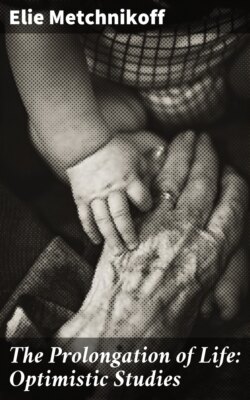Читать книгу The Prolongation of Life: Optimistic Studies - Élie Metchnikoff - Страница 6
На сайте Литреса книга снята с продажи.
ОглавлениеFig. 2.—A Mare, thirty-seven years old.
Fig. 3.—A White Duck, which lived for more than a quarter of a century.
Horses begin to grow old much sooner than elephants. I reproduce (Fig. 2) the photograph of a rare instance of longevity, a mare 37 years old, which belonged to M. Métaine, in the department of Mayenne. The skin, bare in places, but elsewhere covered with long hairs, shows considerable atrophy. The general attitude reveals the feebleness of the whole body. Many birds, on the other hand, show at similar ages very slight external change, as may be seen from the photograph of a duck more than 25 years old (Fig. 3) which belonged to Dr. Jean Charcot. At a still greater age, as may be seen occasionally in parrots, the general debility of the body reveals itself in the attitude, in the condition of the feathers, and in the swelling of the joints. On the other hand, the oldest reptiles which have been observed do not differ in appearance from normal adults of the same species. I have in my possession a male tortoise (Testudo mauritanica) given me by my friends MM. Rabaud and Caullery, and which is at least 86 years old. It shows no sign of old age, and in all respects behaves like any other individual of this species. More than 31 years ago it was wounded by a blow, the traces of which remain visible on the right side of the carapace (Fig. 4). In the last three years the tortoise lived in a garden at Montauban, along with two females which laid fertile eggs. The old male, although, as I have said, probably at least 86 years of age, was still sexually healthy.
Fig. 4.—An Old Land-tortoise.
I have borrowed from the interesting volume of Prof. Sir E. Ray Lankester3 the figure (Fig. 5) and description of a giant tortoise from the island of Mauritius, which is probably the oldest of all living animals. It was brought to Mauritius from the Seychelles in 1764, and has lived since then in the garden of the Governor, and as it has thus already been 140 years in captivity, its age must be at least 150 years, although we have not exact information. Notwithstanding this, it shows no signs of old age.
The examples which I have brought together show that often amongst vertebrates there are some animals the organisms of which withstand the ravages of time much better than that of man. I think it a fair inference that senility, the precocious senescence which is one of the greatest sorrows of humanity, is not so profoundly seated in the constitution of the higher animals as has generally been supposed. It is not necessary, therefore, to discuss at length the general question as to whether senile degeneration is an inevitable event in living organisms.
Fig. 5.—A Water-tortoise, more than 150 years old.
(After Prof. Sir E. Ray Lankester.)
I have already shown, in the “Nature of Man,” the difference which exists between senile degeneration in our own bodies and the phenomena of senescence amongst Infusoria which, as M. Maupas described, are followed by a process of rejuvenescence. According to the more recent results of several investigators, the difference is still greater than I had supposed. Enriquez4 has been able to propagate Infusoria to the 700th generation without any sign of senility being displayed. Here we are far from the condition in the human race.
R. Hertwig,5 one of the best observers of the lower animals, has recently attempted to show that the very simple animalculæ of the genus Actinosphærium are subject to true physiological degeneration. He has several times seen cultures of this Rhizopod degenerate, until all the individuals had died, notwithstanding the presence of abundant food. Prof. Hertwig attributed this to the “constitution of the Actinosphærium having been weakened by too great vital activity at an earlier stage.” I should have thought that it was a much more natural explanation to suppose that the culture had undergone infection by one of the contagious diseases which so often destroy cultures of different kinds of lower animals and plants. As this idea had not occurred to the observer, he had not searched for parasitic microbes amongst the granulations which are always present in the body of an Actinosphærium. However this may be, I cannot accept the facts brought forward by this distinguished German as a valid proof of the existence of senile degeneration in these lowly creatures.
The facts that I have brought together in this chapter justify the conclusion that human beings who reach extreme old age may preserve their mental qualities notwithstanding serious physical decay. Moreover, it is equally plain that the organism of some vertebrates is able to resist the influence of time much longer than is the case with man under present conditions.
